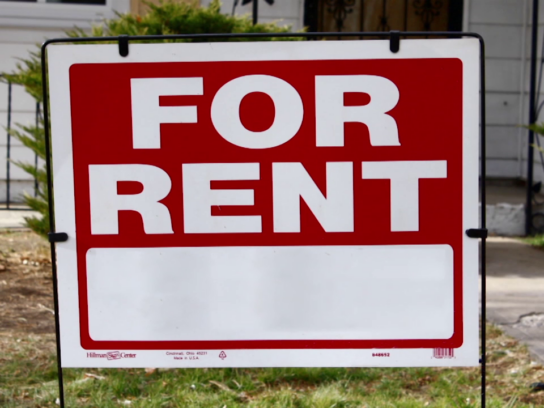
The Montgomery County Planning, Housing and Economic Development (PHED) Committee reviewed a bill on Monday, Oct. 24 that could limit rent increases of more than 4.4% for six months.
If enacted, Expedited Bill 22-22, would stall rent increases of over 4.4% for up to nine months. A clause in the bill would prevent landlords from notifying tenants of increases over that percentage during the six-month period, according to a Montgomery County Council press release.
Landlords in the county are required to notify their tenants of rent increases at least 90 days in advance. This gives tenants an extra three months before they need to pay the elevated rates.
Currently, Montgomery County has no rent stabilization policies, except for the incorporated city of Takoma Park, according to the Montgomery County Department of Housing and Community Affairs (DHCA).
The bill, introduced by County Executive Marc Elrich and sponsored by Council President Gabe Albornoz, follows previous temporary DHCA rent protection policies prompted by the COVID-19 pandemic.
“The county council twice passed legislation that limited the ability of property owners to increase rent during the pandemic out of concern for the welfare of our tenants who were potentially facing significant economic hardship,” said PHED Committee Chair Hans Riemer during the committee work session meeting.
Councilmembers Andrew Friedson and Will Jawando sat on the committee alongside Riemer. Officials from the DHCA, Office of the County Executive and Office of Legislative Oversight sat on a panel to answer committee members’ questions.
Rent Increase Implications
Since May of 2022, after a three-month rent protection period ended, the county has received over 100 complaints of exorbitant rent increases, Riemer said in the work session.
“If we do the math, that means that we’ve had a 200% increase in complaints related to rent increase in five months in comparison to what we would get on a yearly basis,” said Nicolle Katrivanos of Office of Landlord-Tenant Affairs, who sat on the panel, “that is what would trigger the concern for DHCA, as to what the reality is for tenants who are facing rent increases with no caps.”
Average rent prices in Montgomery County have increased over 8% since 2019, according to data from The Washington Post. However, of the complaints reported to the DHCA, analysis shows increases averaging around 22% and reaching over 90%.
“Some of these are unconscionable rent increases, I think it’s fair to say that some of these are price gouging,” said Jake Weissmann, Assistant Chief Administrative Officer at the Office for the County Executive.
Additionally, of the 116 total complaints to the DHCA, 93% were for multifamily properties, meaning that an overwhelming majority of the complaints were families dealing with rent increases rather than people living alone or with roommates.
In many of these instances, people are forced to relocate or negotiate smaller living spaces for a sustainable rent. Jawando recalled a family he met, a single mother and her son, who had to downsize from a two bedroom unit to a one bedroom after a rent increase.
“That would have displaced her, a full time working mom. $50,” he said, “I think we underestimate the severity of these increases on people.”
Downtown Silver Spring resident, Benjamin Bradley, wrote to the council in support of the bill, saying that it “affects me very personally” as he and his partner were offered to renew their lease with elevated monthly rates.
“This would result in an increase in the monthly rent by about $200 to $400,” he said. “This is something not sustainable for us, and while we can make due with this increase, we are now making plans to move elsewhere because the situation is not sustainable for us.”
Director of the DHCA, Aseem Nigam, pointed out that only a small percentage of renters make formal complaints for rent increases because many people don’t know when they have rent increase protections.
This proves an important issue for a county where renters make up approximately 37% of residents, Jawando said, and that number is expected to grow due to rising interest rates pushing homeowners back into the rental market.
This is a troubling reality for some prospective homeowners, who may face rising home values to save for on top of rising rent prices to maintain, all while the median household income remains stagnant, according to the Montgomery County Planning Department’s 2022 Housing Needs Assessment.
In 2018, before the COVID-19 pandemic, the household income required to afford the median home was $125,621, which is above the 2018 median household income of $108,188. The U.S. Census Bureau estimates that the median household income for Montgomery County only rose to around $111,000 by 2020, indicating that the income needed to afford the median-priced home is rising faster than the median household income.
The county needs more affordable housing options for new and incoming residents as well. 1 in 2 new households are low-income, earning under $50,000 annually, according to the Housing Needs Assessment. Particularly along transit corridors in north Bethesda and Rockville, the gain in lower-income households and the loss of affordable units led to a massive increase in housing cost-burdened renters in 2018.
“A vast majority of our residents are already rent burdened, meaning they pay more than 30% of their income on housing,” said Jawando. “That already was happening. Now it’s way higher than that. So we already knew there was a problem, and this is not a’ solve’. The only solution is we must build more affordable housing.”
Additionally, Black and Hispanic renters will bear the brunt of these price increases by facing the most severe cost burdens, meaning that these communities will be spending a higher proportion of income on rent, according to a study from the Harvard Joint Center for Housing Studies.
They report, based on data from the U.S. Census Bureau, that of the population of renter households in the U.S. with cost burdens who are Black, almost 30% will have a severe burden, spending over 50% of their income on rent. Of renter households with cost burdens who are Hispanic, 26% will have a severe level of cost burden as well.
With the county’s diverse population, officials must weigh the impacts of unsupervised rent increases for communities of color. In Montgomery County, over 20% of the population is Black and around 20% of the population is Hispanic, according to the U.S. Census Bureau.
Rent Stabilization Implications
Opponents of the bill expressed concerns that rent protections discourage new developers from bringing much-needed additional housing to the county and that rent control legislation would reduce property tax revenue. Albornoz received many letters of similar nature from development companies and alliances, all expressing their deterrence, should a rent control bill follow through.
President of Sage Ventures, a development and property management company, Gil Horwitz wrote a letter to Albornoz expressing that a rent cap bill would present a “tremendous risk” to their company and the trust of their lenders and investors. “This type of uncertainty will surely preclude us and similar land developers from investing in the future of Montgomery County,” he wrote.
In another one of these letters, the Maryland Building Industry Association wrote, “[W]e feel that a countywide rent cap would do more harm than good long term, disallowing building owners in Montgomery County to keep up with market rates, leaving less money for needed building maintenance and deterring future infrastructure investment in the county, while neighboring jurisdictions continue to thrive without being hamstrung by regulations.”
An Apartment and Office Building Association (AOBA) of Metropolitan Washington study, conducted by the Regional Economic Studies Institute (RESI) at Towson University analyzed the impacts of rent control legislation in Montgomery County. They concluded that “implementing rent control would result in reductions in property values of existing multifamily properties and would significantly decrease county property tax revenue.”
The Montgomery Housing Alliance (MHA) echoed the same sentiment, urging the council to look at anti-gouging policies rather than rent stabilization policies.
The MHA cited a recent NYU Furman Center report with recommendations for an anti-gouging policy model that would “restrict landlords from imposing exorbitant increases, while allowing them to adjust rents within a reasonable margin in order to ensure enough rental income to remain fiscally solvent and properly manage and maintain properties.”
Developers’ complaints may provide some reason as to why of the 150,000 new households built in the Washington D.C. region over the past 12 years, only 5% were in Montgomery County, as the Housing Needs Assessment reported.
With these arguments considered, the committee finished the work session proposing various ways Expedited Bill 22-22 can be modified in the coming review process to tailor to the needs of both renters and developers.
However, the argument surrounding rent protection plans is plagued with misconceptions, as rent control and rent stabilization are often referred to with the same meaning. To distinguish, rent controls enforce strict price caps on how much someone can charge in rent per month. Rent stabilization, on the other hand, limits price increases to a certain percentage. Anti-gouging legislation prevents excessive increases, typically during market shocks like the COVID-19 pandemic.
In this case, the county proposed temporary rent stabilization.
The county was granted powers to implement the temporary stabilization based on emergency policies prompted by the pandemic. Critics of the bill argue that the county no longer has powers to enforce the proposed bill on the basis of an emergency.
“[T]his 6-month extension of rent control currently before the council is not tied to the pandemic, or what is occurring in the rental housing market,” the AOBA argued in a letter to the county council.
The current bill only proposes short term stabilization, but the committee discussed what a hypothetical long-term legislation policy might look like outside the bounds of emergency-appointed policies. In a one case, the St. Paul City Council in Minnesota passed rent control legislation in 2021, following a referendum with 53% approval.
The city has since made numerous changes to the initial law to allow more lenience for landlords struggling to maintain their properties amid inflation, according to a Star Tribune report.
Riemer and Friedson both concurred that more data is needed in the review process before a vote is held by the county council.
In a long-awaited effort to curb the housing shortage, on Tuesday, Oct. 25, the county council voted unanimously in favor of the Thrive 2050 proposal, a development plan that aims to increase affordable housing, improve transit and strengthen local businesses.

